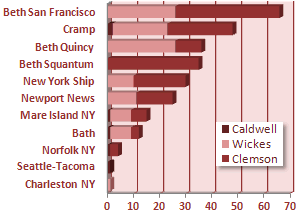

Serious construction did not begin until nearly a year later but in 1918 and 1919, eleven shipyards launched an average of ten hulls per month. Half (137) of the ships were built by Bethlehem Steel at its facilities in San Francisco and Fore River (Quincy, Massachusetts) plus a new yard built for the purpose at nearby Squantum.
Construction of the six Caldwells proceeded slowly: only three commissioned before the armistice (11 November 1918); Seattle’s lone flush-decker, Gwin, did not complete until 1920 (1001 days after her keel was laid, second-slowest of all the flush-deckers).
Fastest to launch of all the flush-deckers was Mare Island Navy Yard’s Ward on an accelerated schedule of 16 days (next-fastest were Squantum’s Reid at 36 days, Quincy’s Maury at 61 days and then 9 more ships—all from Bethlehem yards—in 80–89 days).

Average for Wickes- and Clemson-class hulls launched by the seven largest builders before the armistice was 148 days. This slipped to 185 days in the year after the armistice; then to 331 days for the remaining ships.
Commissionings began in earnest during the third quarter of 1918; 44 ships entered service through 11 November at an average time from launch of 121 days. This, too, slipped thereafter: to 191 days for 99 ships over the next year; then to 308 days for the final 130 ships.
By the end of May 1921, all but four of the 273 flush-deckers had commissioned. Mare Island’s Wasmuth followed that December; Trever (slowest of all to commission at 1087 days after her keel was laid), Perry and Decatur were last in August 1922.